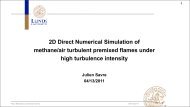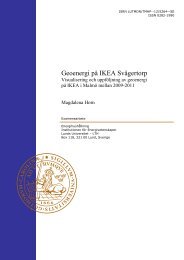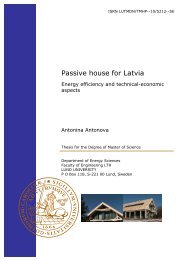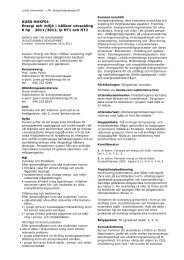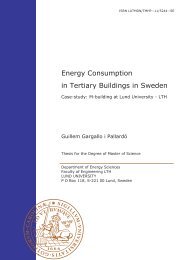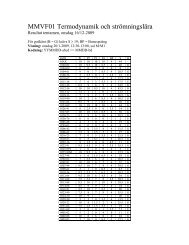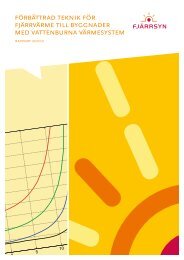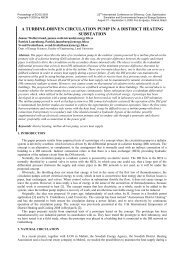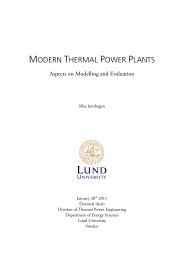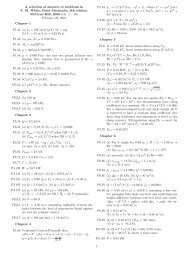Thesis for degree: Licentiate of Engineering
Thesis for degree: Licentiate of Engineering
Thesis for degree: Licentiate of Engineering
Create successful ePaper yourself
Turn your PDF publications into a flip-book with our unique Google optimized e-Paper software.
Table 4.5: Inlet mole fractions <strong>for</strong> the different case studies.<br />
Case models CH 4 CO 2 H 2 O<br />
CH 4 0.45, SF=3 0.191 0.235 0.574<br />
CH 4 0.60, SF=3 0.214 0.143 0.643<br />
CH 4 0.75, SF=3 0.231 0.076 0.692<br />
CH 4 0.60, SF=1 0.375 0.25 0.375<br />
CH 4 0.60, SF=5 0.15 0.1 0.75<br />
Similar to the previous section, the fuel flow rates <strong>for</strong> the different cases were calculated to<br />
keep the fuel utilization at 80 percent. Note that each molecule <strong>of</strong> methane corresponds to a<br />
generation <strong>of</strong> four molecules <strong>of</strong> hydrogen by both the steam re<strong>for</strong>ming and water-gas shift<br />
reaction and each molecule <strong>of</strong> carbon monoxide corresponds to one molecule generation <strong>of</strong><br />
hydrogen. The flow rate <strong>of</strong> air was kept constant <strong>for</strong> all cases and the oxygen utilization is set<br />
to 20 percent. The inlet temperature was set to 1100 K to ensure functional conversion <strong>of</strong> the<br />
fuel and the current density was kept constant at 3000 A/m 2 . The Knudsen diffusion was<br />
neglected in this model to reduce computational cost. For both the steam re<strong>for</strong>ming reaction<br />
and the water-gas shift reaction, the equilibrium model is chosen <strong>for</strong> the kinetic model.<br />
Figure 4.10: Mole fraction distribution in the middle <strong>of</strong> the anode <strong>for</strong> 45% CH 4 (left) and 75% CH 4<br />
(right).<br />
In Figure 4.10, the mole fractions at the centerline <strong>of</strong> the anode along the whole cell length<br />
are presented. The change <strong>of</strong> H 2 O between the different cases is directly connected to the<br />
methane content, in this case, to ensure significant steam at the inlet <strong>of</strong> the cell. Depending on<br />
the inlet fraction a decrease in the mole fraction <strong>of</strong> water can be observed close to the inlet.<br />
The biogas contains no hydrogen in the collected data but <strong>for</strong> numerical calculations the<br />
hydrogen is initially set to have a small inlet value to enable the electrochemical reactions at<br />
the inlet <strong>of</strong> the cell. The variations <strong>of</strong> the mole fractions are however quite small and it is<br />
mostly CO 2 that changes. The reason <strong>for</strong> this is that CO 2 is linked to the choice <strong>of</strong> CH 4 and<br />
47



